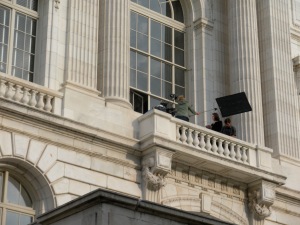Back in September, I had to opportunity to attend a hearing held by the House Oversight Committee as they attempted to find an answer to this very complex question. During the hearing, members of Congress grilled current and former employees of the credit rating agencies that some have blamed for the credit crash.
This story proved to be a huge challenge for me. My strengths do not lie in economics, so I had to do research in the hopes that I could understand what the issue was about. I am proud that I was able to inform myself enough to write a clear and hopefully informative story about a topic that was completely new to me.
What role did credit rating agencies play in the economic downturn?
Nearly a year after it first started looking into credit rating agencies’ part in the economic meltdown, the House Oversight Committee found that the causes of last year’s crash have not gone away.
During his testimony at Wednesday’s hearing, Eric Kolchinsky, former managing director at Moody’s, used the fact that Moody’s is again rating securities that are composed of possibly risky assets as proof that the company is not changing its ways.
“These are the same products which are responsible for hundreds or billions of dollars of losses at major financial institutions . . .,” said Kolinsky, who was suspended because he wrote a letter to the Security and Exchange Commission warning about the company’s lack of oversight. “The ‘new’ methodologies used to rate ABS CDOs have not improved their poor credit performance – many of the recent deals have been downgraded or have had to resort to restructuring to maintain their ratings.”
Ohio Democrat Dennis Kucinich pointed out that the problem of toxic debt is still being bought and sold under a new name, Re-remics, which stands for resecuritizations of real estate mortgage investment conduits. According to Bloomberg, this is another name for mortgage bonds.
Investors rely on credit ratings issued by companies like Moody’s, Standard and Poor’s, and Fitch in order to determine whether it is safe to buy bonds and other debt.
Committee Chairman Rep. Edolphus Towns explained the importance of these credit ratings in the investment market.
“The main mission of credit rating agencies is to tell investors how risky bonds and other debt securities are,” the New York Democrat said. “Pension plans, banks, insurance companies, and other investors depend on these ratings to help them decide where to invest their funds.”
Richard Cantor, the agency’s chief risk officer explained how Moody’s determines its ratings.
He said, “Moody’s credit rating opinions are determined through rating committees, by a majority vote of the committee’s members and not by an individual analyst.”
Despite Cantor’s defense of the agency, many committee members focused on the conflict of interest they saw as inherent in the credit rating industry. Rep. Paul Kanjorski (D–Pa) compared the fact that the groups requesting the ratings pay Moody’s for its services to a hypothetical situation where a judge’s salary is paid by contributions from attorneys who won their cases.
Kolchinsky explained that because an issuer can go from one agency to another in an attempt to get a rating, there is not much incentive for the agency to turn it down.
“Senior management still favors revenue generation over ratings quality and is willing to dismiss or silence employees who disagree with these unwritten policies,” he said.
While admitting that he “would not give a high rating” to Moody’s performance over the last two years, Cantor defended the rating system saying that they did not expect the housing market to fall as quickly as it did.
Many lawmakers suggested instituting some way to regulate the credit rating industry – one way that was recommended would be to impose the same standards on all companies.
Kolchinsky ended his testimony with an endorsement of added oversight of the industry.
“If I were a doctor, I would diagnose the rating agency patient as very curable,” he said “. . . Rating agencies can once again be productive members of the financial community, but they cannot do this by themselves. They need a helping hand to get back on track.”






